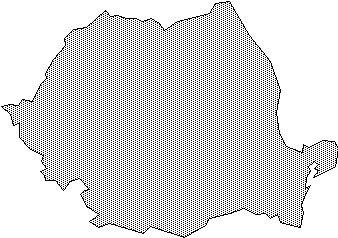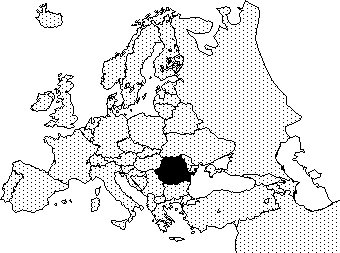[Front page] [Contents] [Previous] [Next] |
Management of Contaminated Sites and Land in Central and Eastern Europe
Romania
Country Characterisation


Background
Total area |
Agricultural areas |
Wooded areas |
Nationally protected areas |
Other areas |
||||
km2 |
km2 |
% |
km2 |
% |
km2 |
% |
km2 |
% |
238381 |
148000 |
62 |
67000 |
28 |
||||
| Figure on total area from UN/ECE, 1998. | ||||||||
Population |
Population density |
Annual pop. growth |
Life expectancy at birth Male Female |
|||||
1000 |
per km2 |
% |
years |
years |
||||
| 22570 | 95 | -0,32 | 65 | 73 | ||||
| Figures from UN/ECE, 1998, and POPIN, 1999. | ||||||||
Legal and Administrative Basis
Definition of Contaminated Sites and Land
There is no specific definition for contaminated sites and land.
Legislation
The following documents are important legislation in respect to contaminated land:
| Law on Environmental Protection (Law no. 137/1995). | |
| Law on Waters: Comprise provisions on contaminated sites and land. |
The Ministerial Orders and Government Decisions related to the Law on Waters contain some provisions regarding land contamination.
Furthermore, a Law on Waste is under discussion in the Parliament.
Implementation of Limit Values
The Ministerial Order (from the Ministry of Water, Forests and Environmental Protection) no. 756 was published in the Official monitor in November 1997. This Ministerial Order comprises the regulations on evaluation of pollution of the environment (water, soil and air). An annex of the regulations comprises the reference and maximum values of pollutant concentrations (alarming and intervention thresholds) in soil.
The Romanian standard no. 4706-88 gives the pollutant concentration limits for surface water quality classifications. The standard no. 1342-88 gives the limit values for drinking water quality.
Responsible Public Authorities
Mainly, the mayoralty, the EPAs, and the Ministry of Water, Forests and Environmental Protection are responsible for monitoring and inspection of contaminated land.
Registration
The project named "Landcover (CORINE Program)" comprises an inventory of contaminated sites.
Characterisation of Soil and Groundwater Contamination
Sources of Soil and Groundwater Contamination
The supervision of the groundwater quality of the main aquifers has been carried out by analysis of water samples collected from some 2000 observation wells, which are included in the national hydrogeological supervision network. To this can be added about 12000 further observation points mainly consisting of:
| Wells for monitoring of contamination located within the radius of potential pollution sources. | |
| Groundwater abstraction wells for water supply. | |
| Water wells mainly located within the rural localities. |
Mainly due to a reduction, during the latest years, of certain intensely polluting industrial activities and also to a decrease of the quantities of agricultural use of chemical and organic fertilisers, a tendency towards improved groundwater quality has been observed.
In some areas, the aquifers are highly polluted with nitrate (NO3-) having concentrations above 45 mg/l, which is the maximum permissible concentration for drinking water in Romania. The causes of the nitrate contamination are complex. An important source is the continuos atmospheric precipitation of various nitrogen oxides (NOx), which has been emitted to the atmospheric air. Another important source is water infiltrating from surface waters (rivers, lakes etc.) to which high loads of nitrates have been discharged. Also, the use of chemical fertilisers on certain types arable land is a source of nitrate contamination. In these areas, nitrate concentrations of more than 100 mg/l are often observed.
Groundwater contamination with oil products has been found in areas near oilfields due to accidents along pipelines and lack of proper monitoring of produced and distributed amounts oil, as well as in areas near petrochemical plants and sites with storage of processed oil products.
Already in 1975, the National Integrated System for monitoring of soil quality was set up. A new monitoring system harmonised with other European systems was set up in 1992. The monitoring system includes 940 representative locations, of which 670 are in agricultural areas and 270 in areas used for forestry purposes. The locations are within 16x16 km2 areas. The soil quality monitoring is organised at three levels: Identification of soil quality conditions, identification of causes of soil contamination, and identification of possible rehabilitation solutions.
Soil pollution in a broad sense is caused by several factors. All in all, for more than 12 million ha of agricultural land soils are subject to the influence of one or several polluters such as erosion, marshing, increasing salt contents, compaction, acidification, and contamination by chemical substances (pesticides, heavy metals, fluorides, oil among others.
Number of Registered Contaminated Sites / Contaminated Land Areas
The number of registered contaminates sites and land areas has been estimated to the following:
| Estimated number of contaminated sites: 1634. | |
| Estimated land area: 164000 ha. |
It is noted that the data are provisional.
Investigation Methods
Identification of Potentially Contaminated Sites and Areas
The contaminated sites and areas are identified with the opportunity of an authorisation process of the activities of various titleholders.
Investigation of Contaminated Sites and Areas
The investigation of contaminated sites and areas is achieved by:
| The certified legal or physical persons who are used to prepare EIAs or Environmental Audits for their activities. | |
| The EPAs inspectorates. | |
| The RAAR (Regia Autonoma Apele Romane) inspectors. | |
| Mayoralties inspectors. | |
| By the site owners (self-monitoring). |
The RAAR is an autonomous national company under the co-ordination of the Ministry of Water, Forests and Environmental Protection.
Facilities for Contaminated Soil
Handling and Treatment of Excavated Contaminated Soil
Up till now, no facilities exist for treatment or proper depositing of contaminated soil.
Measures Used by Remediation of Soil and Groundwater Contamination
Not applicable.
Financing and Liability
Investigation and Remediation Activities
No available data.
Legal Requirements re. Polluters and Site Owners
According to article 14 in the Law on Environmental Protection (Law no. 137/1995) polluters and site owners are required to recover the contaminated land.
Scope of the Problem
Scale of the Problem and Handling Costs
No available data. More studies are needed.
Priority in Relation to Other Societal Problems
Biological reconstruction of contaminated land is included as a priority issue in the Romanian strategy on environmental protection. There are some projects concerning contaminated sites and land provided in the Environmental Action Program on short term.
Illustrative Cases
An on-going project includes biological reconstruction of the Copsa Mica contaminated land.
References
Information provided by Mihai Lesnic at the Ministry of Waters, Forests and Environmental Protection, Research and Engineering Institute for Environment, Romania. March 18 and 19, 1999.
European Environment Agency (1997). Dobris +3 Report. General Questionnaire.
Ministry of Waters, Forests and Environmental Protection. The state of Environment of Romania.
Ministry of Waters, Forests and Environment Protection (1996). Environment Protection Strategy. Study published with the assistance of the EU through the PHARE Programme, Bucharest, Romania.
POPIN (Population Information Network) (1999). The Demography of Countries with Economies in Transition. At gopher://gopher.undp.org/00/ungophers/popin/wdtrends.
UN/ECE Statistical Division (1998). Trends in Europe and North America. 1998 Statistical Yearbook of the UN/ECE. At http://www.unece.org/stats/trend/trend_h.htm. Based on figures from 1994 – 1997.
[Front page] [Contents] [Previous] [Next] [Top] |